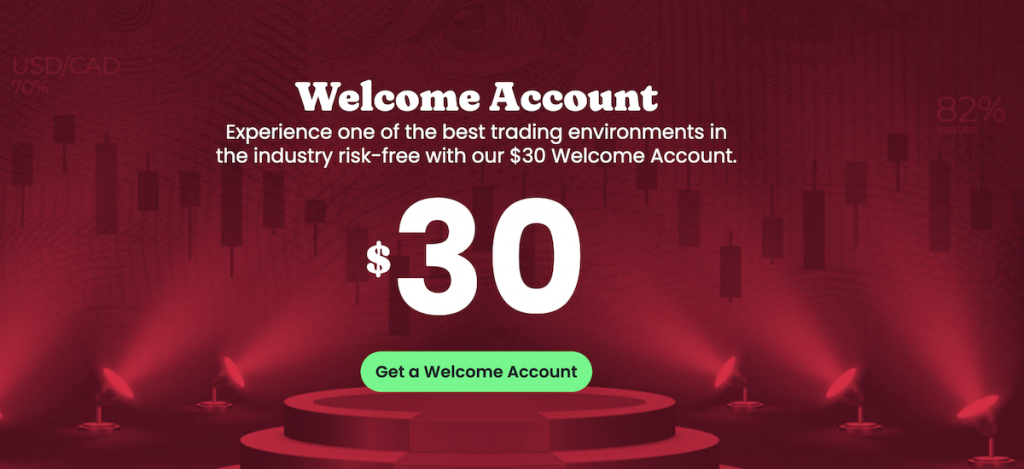Best Swing Trading Brokers With No-Deposit Bonuses 2025

Many new traders want to try swing trading without risking their own money right away. That’s where no-deposit bonuses come in. Sounds simple. But not all brokers or bonuses are the same.
After extensive testing, we’ve highlighted the key factors to consider when searching for a broker that offers no-deposit bonuses, particularly for swing trading.
How No-Deposit Bonuses Work
A no-deposit bonus offers new clients a free amount of money when they open an account. Bonuses can range from as small as $10 to a few hundred dollars. You can use this bonus to trade the broker’s products without requiring any of your own capital.
Even though you don’t have to deposit, there are usually rules before you can withdraw any profits. You may need to trade a specific number of lots or wait a set period, such as a month. The broker may also request that you verify your account and provide identification documents.

$30 is added automatically to your Tickmill ‘Welcome Account’—no deposit needed
Types Of No-Deposit Bonuses
Not every broker’s no-deposit bonuses work the same way. Here are the common considerations:
Bonus Size Vs Trading Style
For swing trading, you hold trades longer and often set wider stop-loss levels. That means you need sufficient margin to keep positions open during normal market fluctuations.
If a broker offers only $5 as a bonus, that’s often too little. You might not even be able to open a single swing trade, especially on forex pairs where margin requirements can be high.
Example:
- A broker gives you a $30 no-deposit bonus.
- You use 1:100 leverage.
- That gives you $3,000 of buying power.
- You open a 0.03 lot trade on EUR/USD (about $3 per pip).
This setup enables you to hold trades overnight without risking an instant account blowout. With only $5, you wouldn’t have this room.
Withdrawal Rules
Most brokers set conditions before you can withdraw profits. Some allow you to withdraw profits only after you trade a specified number of lots. Others allow withdrawal after verifying your account and making a small deposit.
As a swing trader, you might make fewer trades but hold them longer. If a broker requires you to trade 10 full lots to withdraw profits, that’s not realistic for a $30 bonus.
Example:
- Broker A offers a $25 bonus but requires 5 lots to be traded before a profit withdrawal is allowed.
- Broker B gives $20 bonus with only 0.5 lots required.
For swing traders, Broker B is far more practical.
Leverage & Margin
Leverage decides how much you can trade with the bonus. Too low, and you can’t open trades. Too high, and you risk blowing up on small moves.
For swing trading, you usually want moderate leverage. Something like 1:50 or 1:100 is workable. It lets you open positions without overexposure.
Example:
- With $20 and 1:100 leverage, you can control $2,000. Enough for a 0.02 lot trade on EUR/USD.
- With the same $20 but only 1:20 leverage, you control $400. That’s often too small to place even one trade.
Instrument Choice
Some brokers limit what you can trade with the bonus. They may allow only forex majors, or sometimes just one or two pairs.
Swing traders often want more choice. Perhaps you would like to trade gold or indices such as the S&P 500. But if the bonus doesn’t cover them, you’re stuck.
Holding Trades Overnight
Swing trading means holding overnight. Not all brokers handle this the same way.
Two things matter:
- Swap charges: Most brokers charge or pay swap (interest) when you hold overnight. With small bonus accounts, even small swap costs can eat into your balance fast.
- Holding limits: Some brokers forbid holding bonus trades overnight. If that’s the case, it’s useless for swing trading.
Example:
- Broker A allows overnight holding, but charges -$0.20 per night on a small EUR/USD position. After 10 nights, that’s $2 gone from your $20 bonus.
- Broker B allows overnight holding with lower swaps, say -$0.05. You keep more of the bonus alive.
Time Limits On The Bonus
Some bonuses expire after seven or 30 days. That’s a problem for swing traders, who may wait weeks for a trade to play out.
If you have only seven days, you may be forced to take unfavorable trades just to utilize the bonus. That’s not good practice.
Platform & Tools
Swing trading often relies on charts, indicators, and sometimes alerts. If the broker’s bonus account only works on a limited app, it can feel restrictive.
The standard platforms are MetaTrader 4 (MT4), MetaTrader 5 (MT5), or cTrader. These are fine for swing trading because they offer charting tools and order management.
Risk Of Bonus Removal
Some brokers cancel bonuses if you break rules, like hedging, scalping, or opening multiple accounts. For swing trading, you don’t usually run into these rules. But check anyway.
Example:
- You open a EUR/USD trade and hold for 10 days. If the broker suddenly removes the bonus, your open trade may be closed due to margin loss.
Using The Bonus As Practice
A no-deposit bonus is not free money for living expenses. Think of it as a practice tool. It allows you to test swing trading with real market conditions, but without risking your own cash.
Example:
- You take a swing trade on GBP/USD with a $25 bonus.
- You set a stop-loss 50 pips away. That’s about $12.50 risk.
- If it works, you might make a profit of $20 to $30.
This is real-world learning. You see how it feels to wait days, manage swaps, and ride out volatility. Even if you can’t withdraw much, the experience is valuable.
Realistic Expectations
Don’t expect to get rich from a no-deposit bonus. They’re small by design. The point is to practice swing trading with live conditions, learn how brokers operate, and maybe withdraw a small profit if conditions allow.
If you make $10–50 in profit and manage to withdraw it, that’s already a win.
I tried swing trading with a no-deposit bonus to see how it felt in real market conditions. The bonus gave me room to experiment, but it also taught me quickly that small accounts can disappear just as fast as they grow. It’s a good way to learn, not a shortcut to profit.
Final Thoughts
When you’re looking at the best no-deposit bonuses for swing trading, the goal isn’t to grab the biggest free offer. What really matters is whether the bonus makes swing trading possible.
A bonus that’s too small, tied up with strict withdrawal rules, or limited by time will do more harm than good.
You want enough margin to hold trades, fair conditions for taking profits, and the ability to keep positions open overnight. The bonus should give you time to let trades play out, rather than forcing you to rush.
Think of these bonuses less as a way to make money and more as a training tool. They let you practice in real markets without risking your own cash.
Even if the profits are small, you’ll learn how to manage positions, deal with swaps, and handle the emotions of holding trades for days or weeks.
If you can withdraw a little profit, that’s a nice bonus. However, the real value lies in the experience you build before investing your own money.
